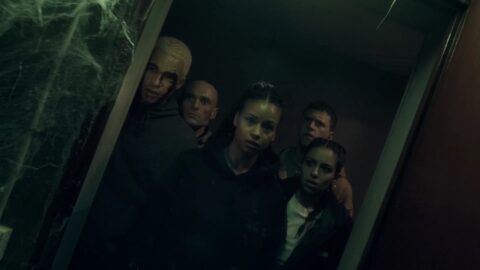I have no qualms with spiders. I’m rarely scared of them. Unlike other insects, most notably flies, they’re pretty happy to be taken outside with just one scoop of a glass and a piece of paper. I’ve never seen a spider and screamed. I’ve certainly never referred to one as the “size of a Buick.”
But after watching Vermin (Sébastien Vanícek, 2023), I’ve changed my mind. One of the creepiest, crawliest, downright nastiest creature-features I’ve ever witnessed, Vermin has turned me into an avid hater of those abysmal arachnids.
It starts with a well-known truth: if a movie starts with men in the Saharan desert uncovering something mysterious in a big hole, you know it’s going to escape and cause some serious damage. One of these unpleasant arthropods is captured and ends up in the hands of Ali (Samir Nait) who, alongside his dodgy jewellery business, runs a dodgy sideline in exotic creatures. Calling himself the original Ali Express, he has no idea how lethal his latest acquisition is. So when the charming Kaleb (Théo Christine), offers to take it off his hands, he gives him the beastly spinner for a mere 20 euros.
It’s easy to think badly of Kaleb, a reckless young man who doesn’t know what he’s doing, but it turns out that he’s an avid collector of rare specimens, from snakes to fish to dictator scorpions. Christine imbues his hero with genuine warmth and interest; not only in all things reptilian and insect-like, but also in the diverse working-class milieu that makes up his forgotten building in a forgotten corner of Paris. Nonetheless, when the dangerous araneomorphae finally escapes from his room and starts rapidly multiplying — while also getting exponentially bigger — he is forced to come to terms with his own recklessness while also finding a way to rescue his family and friends.
There were so many opportunities for Vermin to turn into a little goofy late-night thrill, yet debut director Sébastien Vanícek is committed to the full potential of the genre, both thematically and dramatically.
For one, Vanicek and Florent Bernard’s air-tight screenplay could be taught in schools as a paragon of how to use little details to build up suspense, toying with our expectations as the spider starts laying eggs and all hell breaks loose, bringing to mind the first two Alien movies in its economy of detail.
It helps that the emotional ties, whether it’s between Kaleb and his sister Manon (Lisa Nyarko) or his estranged friend Jordy (Finnegan Oldfield), are finely rendered too, giving us something to hold on to as these young adults run for their lives.
Even more impressive is how all this is folded into a comment on the relationship between the increasingly authoritarian French police and their relationship with people living in the Banlieu. For example, when the apartment building is completely quarantined to stop the spiders from escaping, and the police seemingly condemn working-class and people of colour to their deaths, the pointed political subtext shows how Macron’s France simply isn’t working.
Representing this moral rot is the exquisite production design. The apartment block, already resembling the slum tenement of The Super (Rod Daniel, 1991), is slowly transformed from a run-down, dingy building with intermittent power, into a kind of makeshift Shelob’s Lair — infested with cocoons, nests, bodies buried in silk, and all kinds of ugliness lingering in the corners. Only the brief presence of light, as we know from The Return of the King (Peter Jackson, 2003), can seem to ward these beasties away long enough for our heroes to make quick darts into safe spaces. Manipulating this space and probing its darknesses with ease, Alexandre Jamin’s bold cinematography switches from handheld to whip pans to drone shots as and when the scene needs it — even making use of an impressive 360-degree reverse zoom in the film’s standout, most revelatory shot.
As for the spiders themselves, those ugly little buggers, they make a great example of how CGI, when used properly, can enhance horror immeasurably. While the computer-generated spiders (acting alongside their real counterparts) do look more or less photorealistic, their terrors lie far more in their suggestive power — seen in the reflection of a mirror, making creepy clicking sounds, slowly emerging from a human’s mouth — than in their full-frontal glare. I was terrified more or less the whole time, especially as the spiders grew to the size of Buicks.
Redmond is the editor-in-chief of Journey Into Cinema.
